EIZO FlexScan EV2736W User manual
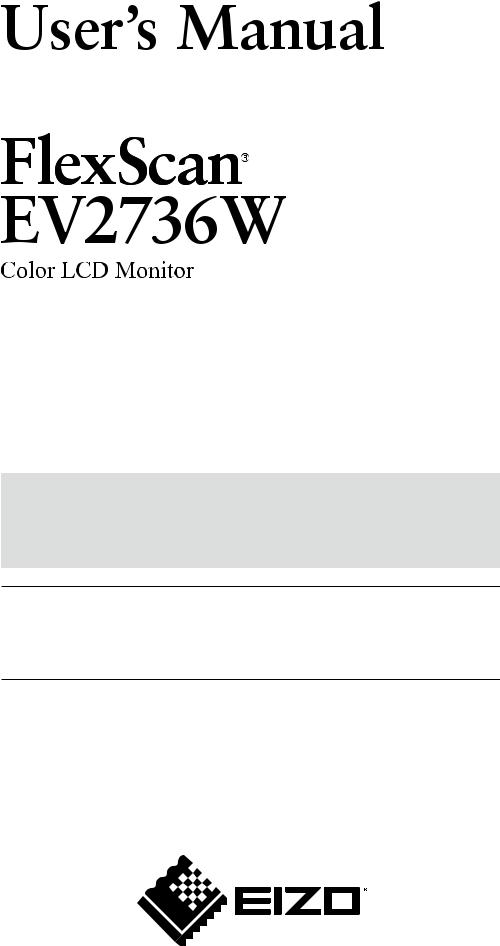
Important
Please read PRECAUTIONS, this User’s Manual, and the Setup Guide (separate volume) carefully to familiarize yourself with safe and effective usage.
•Please refer to the Setup Guide for basic information ranging from connection of the monitor to a PC to using the monitor.
•The latest User’s Manual is available for download from our web site: http://www.eizo.com
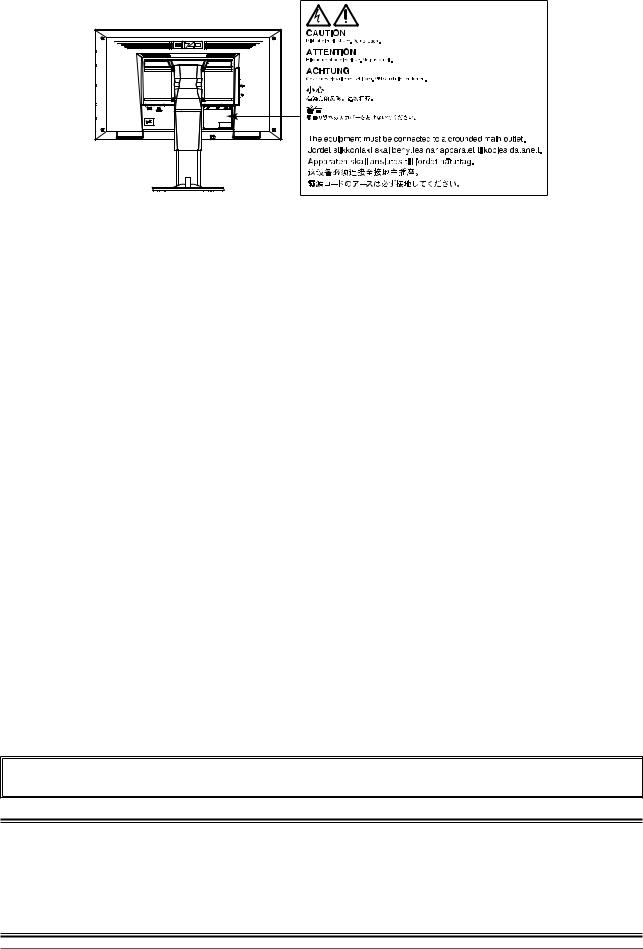
Location of Caution Statement
This product has been adjusted specifically for use in the region to which it was originally shipped. If operated outside this region, the product may not perform as stated in the specifications.
No part of this manual may be reproduced, stored in a retrieval system, or transmitted, in any form or by any means, electronic, mechanical, or otherwise, without the prior written permission of EIZO Corporation.
EIZO Corporation is under no obligation to hold any submitted material or information confidential unless prior arrangements are made pursuant to EIZO Corporation’s receipt of said information. Although every effort has been made to ensure that this manual provides up-to-date information, please note that EIZO monitor specifications are subject to change without notice.
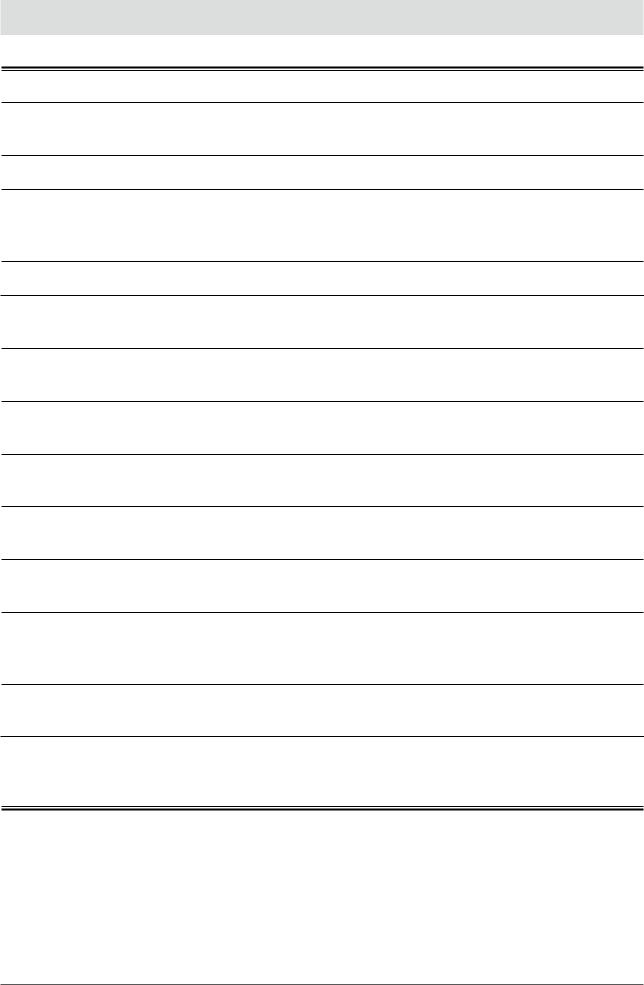
Notice for this monitor
This product is suited to general purposes like creating documents, viewing multimedia content.
This product has been adjusted specifically for use in the region to which it was originally shipped. If the product is used outside the region, it may not operate as specified in the specifications.
This product may not be covered by warranty for uses other than those described in this manual.
The specifications noted in this manual are only applicable when the following are used:
·Power cords provided with the product
·Signal cables specified by us
Only use optional products manufactured or specified by us with this product.
It takes about 30 minutes for the performance of electrical parts to stabilize. Please wait 30 minutes or more after the monitor power has been turned on, and then adjust the monitor.
Monitors should be set to a lower brightness to reduce changes in luminosity caused by long-term use and maintain a stable display.
When the screen image is changed after displaying the same image for extended periods of time, an afterimage may appear. Use the screen saver or power save function to avoid displaying the same image for extended periods of time.
Periodic cleaning is recommended to keep the monitor looking new and to prolong its operation lifetime (refer to “Cleaning” (page 4)).
The LCD panel is manufactured using high-precision technology. Although, missing pixels or lit pixels may appear on the LCD panel, this is not a malfunction. Percentage of effective dots: 99.9994% or higher.
The backlight of the LCD panel has a fixed lifetime. When the screen becomes dark or begins to flicker, please contact your local EIZO representative.
Do not press on the panel or edge of the frame strongly, as this may result in display malfunctions, such as interference patterns, etc. If pressure is continually applied to the panel, it may deteriorate or damage your panel. (If the pressure marks remain on the panel, leave the monitor with a black or white screen. The symptom may disappear.)
Do not scratch or press on the panel with any sharp objects, as this may result in damage to the panel. Do not attempt to brush with tissues as this may scratch the panel.
When the monitor is cold and brought into a room or the room temperature goes up quickly, dew condensation may occur on the interior and exterior surfaces of the monitor. In that case, do not turn the monitor on. Instead wait until the dew condensation disappears, otherwise it may cause some damage to the monitor.
Notice for this monitor |
3 |

Cleaning
Attention
•Chemicals such as alcohol and antiseptic solution may cause gloss variation, tarnishing, and fading of the cabinet or panel, and also quality deterioration of the image.
•Never use any thinner, benzene, wax, and abrasive cleaner, which may damage the cabinet or panel.
Note
• The optional ScreenCleaner is recommended for cleaning the cabinet and panel surface.
If necessary, the stains on the cabinet and panel surface can be removed by moistening part of a soft cloth with water.
To use the monitor comfortably
•An excessively dark or bright screen may affect your eyes. Adjust the brightness of the monitor according to the environmental conditions.
•Staring at the monitor for a long time tires your eyes. Take a 10-minute rest every hour.
4Notice for this monitor
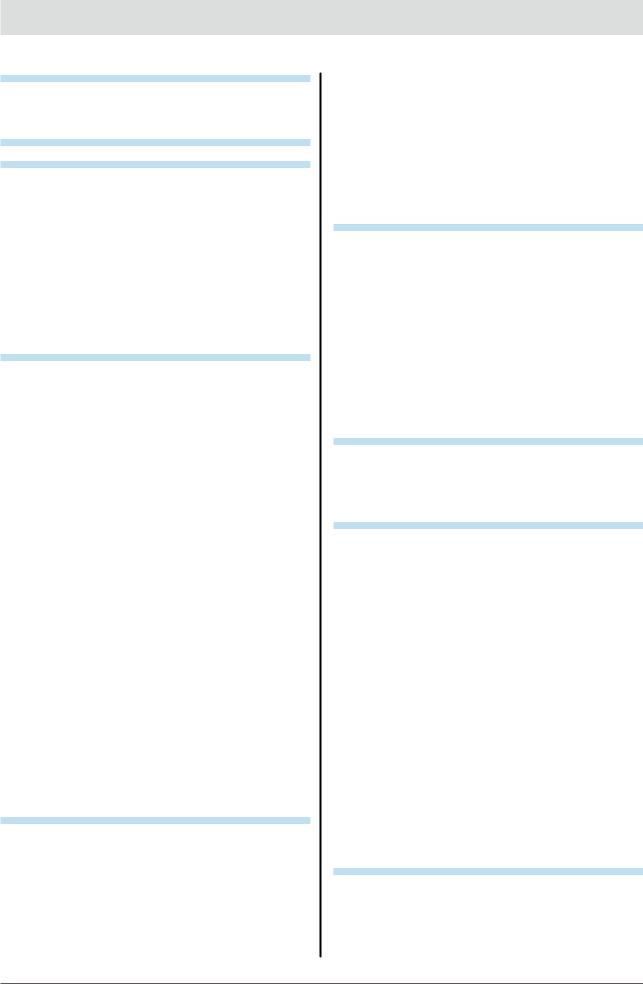
CONTENTS
Notice for this monitor.......................................... |
3 |
||
.....................................................................Cleaning |
|
4 |
|
To use the monitor comfortably.............................. |
4 |
||
CONTENTS............................................................. |
|
5 |
|
Chapter 1 |
.......................................Introduction |
7 |
|
1-1. |
..........................................................Features |
7 |
|
1-2. |
Controls and Functions................................ |
9 |
|
1-3. |
EIZO LCD Utility Disk................................... |
10 |
|
●● |
|
10 |
|
|
Disk contents and software overview............. |
||
●● |
|
|
|
|
To use “ScreenManager Pro for LCD |
|
|
|
(DDC/CI) / EIZO ScreenSlicer”....................... |
10 |
|
1-4. |
Basic Operations and Functions................ |
11 |
|
●● |
|
11 |
|
|
Basic operation of the Setting menu.............. |
||
●● |
|
12 |
|
|
Functions........................................................ |
||
Chapter 2 |
Adjusting Screens........................... |
13 |
|
2-1. |
..............................Compatible Resolutions |
13 |
|
●● |
|
13 |
|
|
Digital Input (DVI-D)........................................ |
||
●● |
|
13 |
|
|
Digital Input (DisplayPort)............................... |
||
2-2. |
Setting the Resolution................................. |
14 |
|
●● |
|
14 |
|
|
Windows 8 / Windows 7.................................. |
||
●● |
|
14 |
|
|
Windows Vista................................................ |
||
●● |
|
14 |
|
|
Windows XP.................................................... |
||
●● |
|
14 |
|
|
Mac OS X........................................................ |
||
2-3. |
Adjusting Color............................................. |
15 |
|
●● |
|
|
|
|
To select the display mode |
|
|
|
(FineContrast Mode)....................................... |
15 |
|
●● |
|
15 |
|
|
To perform advanced adjustments................. |
||
●● |
|
16 |
|
|
Adjustable settings in each mode................... |
||
●● |
|
16 |
|
|
To adjust brightness........................................ |
||
●● |
|
17 |
|
|
To adjust contrast............................................ |
||
●● |
|
17 |
|
|
To adjust color temperature............................ |
||
●● |
|
18 |
|
|
To adjust gamma ........................................... |
||
●● |
|
18 |
|
|
To adjust the color saturation......................... |
||
●● |
|
19 |
|
|
To adjust hue................................................... |
||
●● |
|
19 |
|
|
To set overdrive intensity................................ |
||
●● |
|
20 |
|
|
To adjust gain................................................. |
||
2-4. |
Screen Size Changing................................. |
20 |
|
●● |
|
20 |
|
|
Screen Size Changing................................... |
||
●● |
|
21 |
|
|
To modify blurred characters / lines............... |
||
Chapter 3 |
Setting Monitor................................ |
22 |
|
3-1. |
........................................Adjusting Volume |
22 |
|
3-2. |
Selecting sound source while using the |
|
|
|
DisplayPort signal input............................. |
22 |
|
3-3. |
Enabling / Disabling DDC/CI |
|
|
|
communication ........................................... |
22 |
|
3-4. |
Locking Operation Buttons........................ |
23 |
|
3-5. |
Showing and hiding the EIZO logo............ |
23 |
|
3-6. |
Changing Setting Menu Display Position... |
23 |
|
3-7. |
Setting Language........................................ |
24 |
|
3-8. |
Resetting the Monitor to the Default |
|
|
|
Settings......................................................... |
25 |
|
●● |
|
25 |
|
|
To reset the color adjustments...................... |
||
●● |
|
25 |
|
|
To reset “EcoView Sense Settings”............... |
||
●● |
|
|
|
|
To reset all adjustments to the default |
|
|
|
settings........................................................... |
25 |
|
Chapter 4 Power Saving Functions................. |
26 |
||
4-1. |
..................................Setting Power Saving |
26 |
|
●● |
|
26 |
|
|
Monitor........................................................... |
||
●● |
|
26 |
|
|
Audio Output.................................................. |
||
4-2. |
Setting Power Indicator.............................. |
27 |
|
4-3. |
Enabling / Disabling Automatic |
|
|
|
Brightness Adjustment .............................. |
27 |
|
4-4. |
Setting the power saving mode when a |
|
|
|
person leaves the monitor.......................... |
28 |
|
4-5. |
Checking the power saving level............... |
30 |
|
4-6. |
Enabling / Disabling Auto Power-OFF...... |
30 |
|
Chapter 5 |
Troubleshooting.............................. |
31 |
|
5-1. |
......................................................No picture |
31 |
|
5-2. |
Imaging problems........................................ |
32 |
|
5-3. |
Other problems............................................ |
33 |
|
Chapter 6 |
Reference......................................... |
34 |
|
6-1. |
.......................Attaching the Optional Arm |
34 |
|
6-2. |
Detaching/Attaching Stand Base.............. |
35 |
|
6-3. |
Attaching/Detaching Cable Holder............ |
38 |
|
6-4. |
Connecting Multiple PCs............................ |
40 |
|
●● |
|
40 |
|
|
To switch among input signals....................... |
||
●● |
|
41 |
|
|
To set input signal selection............................ |
||
6-5. |
Making Use of USB (Universal Serial |
|
|
|
Bus)................................................................ |
41 |
|
●● |
|
41 |
|
|
Required System Environment....................... |
||
●● |
|
|
|
|
Connection Procedure (Setup of USB |
|
|
|
Function)......................................................... |
42 |
|
6-6. |
Displaying Monitor Information................. |
42 |
|
6-7. |
Specifications.............................................. |
43 |
|
●● |
|
44 |
|
|
Main Default Settings..................................... |
||
●● |
|
44 |
|
|
Outside Dimensions....................................... |
||
●● |
|
44 |
|
|
Accessories................................................... |
||
6-8. |
Glossary....................................................... |
45 |
|
Appendix............................................................... |
|
47 |
|
.................................................................Trademark |
47 |
||
License...................................................................... |
|
47 |
|
ENERGY STAR.......................................................... |
47 |
||
TCO |
........................................................................... |
|
48 |
CONTENTS 5

FCC Declaration of Conformity............................. |
48 |
Hinweise zur Auswahl des richtigen |
|
Schwenkarms für Ihren Monitor............................ |
49 |
Hinweis zur Ergonomie :........................................ |
49 |
LIMITED WARRANTY............................................. |
50 |
Recycling Information............................................ |
59 |
China Measures for RoHS Compliance in |
|
ChinaRoHS.............................................................. |
63 |
6CONTENTS

Chapter 1 Introduction
Thank you very much for choosing an EIZO color LCD monitor.
1-1. Features
•27.0″ wide format LCD
•Supports a resolution of 2560 × 1440
•IPS panel with 89˚ horizontal and vertical viewing angles
•Applicable to DisplayPort (applicable to 8 bit)*1
The DisplayPort input receives both an image signal and an audio signal via a single DisplayPort cable.
*1 When transmitting an audio signal using the DisplayPort cable, the graphics board must be compatible with audio output (see “6-7. Specifications” (page 43)).
•The FineContrast function allows the user to select the display mode optimum to the displayed image. -- The Paper mode reproduces a printed paper effect on the monitor.
See “To select the display mode (FineContrast Mode)” (page 15).
•The software “ScreenManager Pro for LCD (DDC/CI)” to adjust the screen using the mouse and keyboard is included
See “1-3. EIZO LCD Utility Disk” (page 10).
-- EyeCare Filter
Texture of the paper is reproduced by displaying a translucent image in the foreground of the desktop. By using this function with the Paper mode, the screen looks more like paper.
See “To select the display mode (FineContrast Mode)” (page 15).
•Supports the power management software “EIZO EcoView NET”
For more information, refer to our web site (http://www.eizo.com).
•Power saving function
Suppressing the power consumption*2 reduces the carbon dioxide emissions. This product is equipped with power saving function.
-- 0 W power consumption when the main power is off
Equipped with main power switch.
When the monitor is not required, the power supply can be shut off using the main power switch.
-- Auto EcoView
The ambient light sensor on the front side of the monitor detects the environmental brightness to adjust the screen brightness automatically and comfortably. Excessively high brightness may increase power consumption and cause unwanted environmental effects. It may also lead to fatigue of your eyes. Use the Auto EcoView to reduce the brightness.
See “4-3. Enabling / Disabling Automatic Brightness Adjustment” (page 27).
-- EcoView Sense
The sensor on the front side of the monitor detects the movement of a person. When a person moves away from the monitor, the monitor shifts to the power saving mode automatically and does not display the images on the screen. Therefore, the function reduces the power consumption. The sensitivity and time until the power saving mode is activated can be set according to the monitor usage environment and movement of the user.
See “4-4. Setting the power saving mode when a person leaves the monitor” (page 28). *2 Reference values:
Maximum power consumption: 67 W (Brightness Max., when a USB device is connected, speaker working, at default settings)
Standard power consumption: 24 W (Brightness 120 cd/m2, when no USB device is connected, speaker not working, at default settings)
•Supports portrait and landscape formats
•Displays HDCP (High-bandwidth Digital Protection) protected contents.
Chapter 1 Introduction |
7 |

Note
•When using the monitor screen in a portrait position, the graphics board supporting portrait display is required. When placing the monitor in a portrait position, the settings of your graphics board need to be changed. Refer to the User’s Manual of the graphics board for details.
8Chapter 1 Introduction
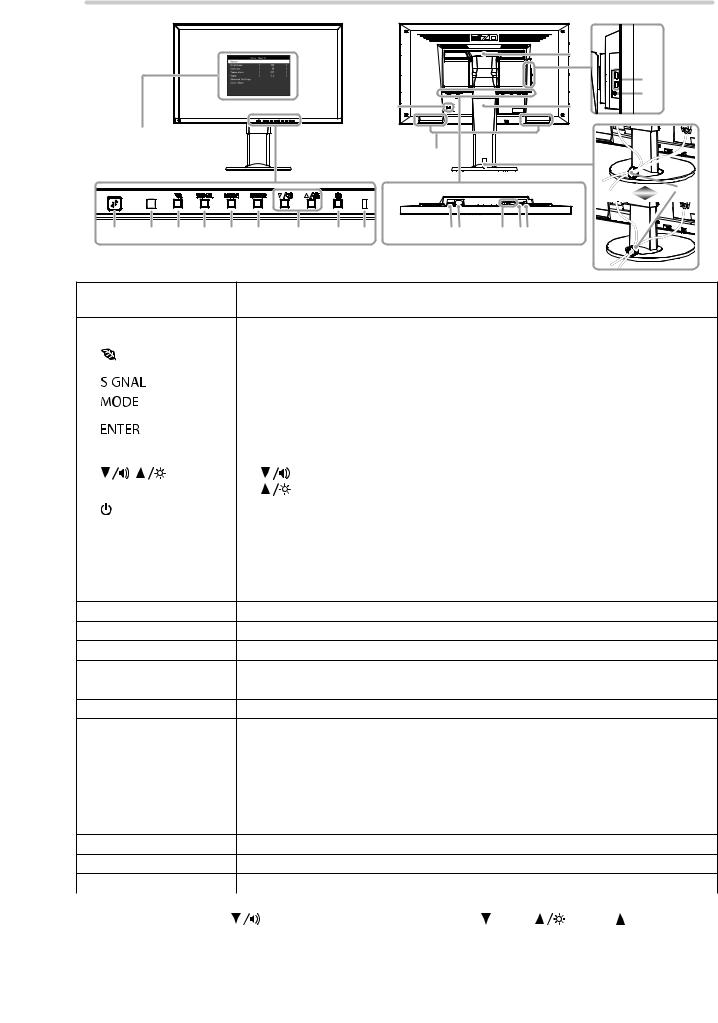
1-2. Controls and Functions |
|
|
|
17 |
|
|
|
19 |
15 |
18 |
20 |
|
||
Setting menu*1 |
|
|
|
16 |
|
|
|
21 |
1 |
2 |
3 |
4 |
5 |
6 |
7 |
8 |
9 |
1011 |
121314 |
1. EcoView Sense sensor Detects the movement of a person in front of the monitor (EcoView Sense function (page 28)).
2. |
Ambient light sensor |
Detects ambient brightness (Auto EcoView function (page 27)). |
||||
3. |
|
button |
Displays the setting menu of the power saving function (Auto EcoView (page 27) and |
|||
|
EcoView Sense (page 28)). |
|||||
|
|
|
|
|||
4. |
|
|
button |
Switches input signals for display (page 40). |
||
|
|
|||||
|
|
|
|
|
|
|
5. |
|
|
button |
Changes the FineContrast mode (page 15). |
||
6. |
|
|
button |
Displays the Setting menu, determines an item on the menu screen, and saves values |
||
|
|
adjusted (page 11). |
||||
|
|
|
|
|||
|
|
|
button*2 |
• Provides the menu selection as well as the adjustment and setting of a function. |
||
7. |
, |
• |
button: Displays the volume adjustment menu (page 22). |
|||
|
|
|
|
|
button: Displays the Brightness adjustment menu (page 16). |
|
8. |
|
button |
Turns the power on or off. |
|||
|
|
|
|
Indicates the monitor’s operation status. |
||
9. |
Power indicator |
Blue: |
Operating |
|||
Orange: |
Power saving mode |
|||||
|
|
|
|
|||
|
|
|
|
OFF: |
Main power / Power off |
|
10.Main power switch Turns the main power on or off.
11.Power connector Connects the power cord.
12.Input signal connector Left: DisplayPort connector / Right: DVI-D connector
13. |
Stereo mini jack |
Connects the stereo mini jack cable (commercially available product). |
14. |
USB port (UP) |
Connects the USB cable for using the USB Hub function (page 41). |
15. Security lock slot Complies with Kensington’s MicroSaver security system.
16. |
Speaker |
Outputs audio source. |
|||
|
|
Handle used for transportation |
|||
|
|
|
|
|
|
|
|
|
|
|
|
17. |
Handle |
|
Attention |
||
• Firmly grasp and hold the monitor by the bottom while grabbing the handle, and carefully |
|||||
|
|
||||
|
|
|
convey the monitor so as not to drop it. |
||
|
|
|
|
|
|
|
|
|
|
|
|
18. |
Stand*3 |
Adjusts the height and angle (tilt and swivel) of the monitor. |
|||
19.USB port (DOWN) Connects a peripheral USB device.
20.Headphone jack Connects the headphones.
21. Cable holder |
Covers the monitor cables. |
|
|
|
*1 See “1-4. Basic Operations |
Functions” (page 11) for how to use. |
|
|
|
*2 |
In this User’s Manual, |
button may be hereafter simply displayed as , and |
button as . |
|
*3 |
An optional arm (or an optional stand) can be attached by removing the stand (see “6-1. Attaching the Optional Arm” (page 34)). |
|||
|
|
|
|
|
|
|
|
Chapter 1 Introduction |
9 |

1-3. EIZO LCD Utility Disk
An “EIZO LCD Utility Disk” (CD-ROM) is supplied with this product. The following table shows the disk contents and the overview of the software programs.
●●Disk contents and software overview
The disk includes software programs for adjustment, and User’s Manual. Refer to Readme.txt file on the disk for software startup procedures or file access procedures.
Item |
Overview |
Windows |
Macintosh |
|
Screen adjustment pattern files*1 |
Used when adjusting the image of analog |
√ |
√ |
|
|
signal input manually. |
|||
|
|
|
||
ScreenManager Pro for LCD |
Software for adjusting the screen using the |
√ |
- |
|
(DDC/CI) |
mouse and keyboard. |
|||
|
|
|||
EIZO ScreenSlicer |
Software that divides a screen and lays out |
√ |
- |
|
|
multiple windows efficiently. |
|||
|
|
|
||
User’s Manual of this monitor (PDF file) |
√ |
√ |
||
Readme.txt file |
|
√ |
√ |
|
*1 This monitor does not support analog signal input, so these files are not used.
●●To use “ScreenManager Pro for LCD (DDC/CI) / EIZO ScreenSlicer”
For the installation and use of “ScreenManager Pro for LCD (DDC/CI) / EIZO SceenSlicer”, refer to the respective User’s Manual on the disk.
10 Chapter 1 Introduction

1-4. Basic Operations and Functions
●●Basic operation of the Setting menu
1.Displaying the Setting menu
1. Press 
 . The Setting menu appears.
. The Setting menu appears.
2.Adjusting / Setting
1. Choose a menu to adjust / set with , , and then press |
. The Sub menu appears. |
2. Choose an item to adjust / set with , , and then press |
. The adjustment / setting menu appears. |
3. Adjust / set the selected item with , , and then press |
. |
3.Exiting
1.Choose “Return” from the Sub menu and press 
 . The Setting menu appears.
. The Setting menu appears.
2.Choose “Exit” from the Main menu and press 
 . The Setting menu quits.
. The Setting menu quits.
Note
• The Setting menu can also be exited by pressing |
twice quickly. |
|
|
Chapter 1 Introduction 11

●● |
|
|
|
|
Functions |
|
|
|
|
The following table shows the Setting menu and setting items of each menu. |
||||
|
|
|
|
|
|
Main menu |
Setting |
Reference |
|
|
Color*1 |
Brightness |
|
“2-3. Adjusting Color” (page 15) |
|
|
Contrast |
|
|
|
|
Temperature |
|
|
|
|
Gamma |
|
|
|
|
Advanced Settings |
Saturation |
|
|
|
|
Hue |
|
|
|
|
Overdrive |
|
|
|
|
Gain |
|
|
|
Color Reset |
|
“To reset the color adjustments” (page 25) |
|
Screen |
Screen Size |
|
“Screen Size Changing” (page 20) |
|
|
Smoothing |
|
“To modify blurred characters / lines” |
|
|
|
|
(page 21) |
|
Sound |
Source |
|
“3-2. Selecting sound source while using |
|
|
|
|
the DisplayPort signal input” (page 22) |
|
|
Power Save |
|
“Audio Output” (page 26) |
|
PowerManager |
Power Save |
|
“4-1. Setting Power Saving” (page 26) |
|
|
Eco Timer |
|
“4-6. Enabling / Disabling Auto Power- |
|
|
|
|
OFF” (page 30) |
|
Monitor Settings |
Input Signal |
|
“To set input signal selection” (page 41) |
|
|
Power Indicator |
|
“4-2. Setting Power Indicator” (page 27) |
|
|
Language |
|
“3-7. Setting Language” (page 24) |
|
|
DDC/CI |
|
“3-3. Enabling / Disabling DDC/CI |
|
|
|
|
communication” (page 22) |
|
|
Menu Settings |
Logo |
“3-5. Showing and hiding the EIZO logo” |
|
|
|
|
(page 23) |
|
|
|
Menu Position |
“3-6. Changing Setting Menu Display |
|
|
|
|
Position” (page 23) |
|
|
Reset |
|
“To reset all adjustments to the default |
|
|
|
|
settings” (page 25) |
|
Information |
|
|
“6-6. Displaying Monitor Information” |
|
|
|
|
(page 42) |
*1 The adjustment / settings available on the “Color” menu depend on the selected Color mode ("Adjustable settings in each mode" (page 16)).
12 Chapter 1 Introduction

Chapter 2 Adjusting Screens
2-1. Compatible Resolutions
The monitor supports the following resolutions.
●●Digital Input (DVI-D)
Resolution |
Applicable Signals |
Vertical Scan |
Dot Clock |
||
Frequency |
|||||
|
|
|
|
||
640 |
× 480 |
VGA, CEA-861 |
60 Hz |
|
|
720 |
× 400 |
VGA TEXT |
70 Hz |
|
|
800 |
× 600 |
VESA |
60 Hz |
|
|
1024 × 768 |
VESA |
60 Hz |
|
||
1280 × 720 |
CEA-861 |
60 Hz |
|
||
1280 × 960 |
VESA |
60 Hz |
242 MHz |
||
1280 |
× 1024 |
VESA |
60 Hz |
||
1600 |
× 1200 |
VESA |
60 Hz |
(Max.) |
|
1680 |
× 1050 |
VESA CVT, VESA CVT RB |
60 Hz |
|
|
1920 |
× 1080 |
CEA-861 |
60 Hz |
|
|
1920 × 1200*1 |
VESA CVT |
60 Hz |
|
||
1920 |
× 1200 |
VESA CVT RB |
60 Hz |
|
|
2560 × 1440*1*2 |
VESA CVT RB |
60 Hz |
|
||
2560 |
× 1440 |
WQHD (Single Link) |
30 Hz |
|
|
●●Digital Input (DisplayPort)
Resolution |
Applicable Signals |
Vertical Scan |
Dot Clock |
||
Frequency |
|||||
|
|
|
|
||
640 |
× 480 |
VGA, CEA-861 |
60 Hz |
|
|
720 |
× 400 |
VGA TEXT |
70 Hz |
|
|
720 × 480 (4:3) |
CEA-861 |
60 Hz |
|
||
720 × 480 (16:9) |
CEA-861 |
60 Hz |
|
||
800 |
× 600 |
VESA |
60 Hz |
|
|
1024 × 768 |
VESA |
60 Hz |
|
||
1280 × 720 |
CEA-861 |
60 Hz |
242 MHz |
||
1280 × 960 |
VESA |
60 Hz |
|||
1280 |
× 1024 |
VESA |
60 Hz |
(Max.) |
|
1600 |
× 1200 |
VESA |
60 Hz |
|
|
1680 |
× 1050 |
VESA CVT, VESA CVT RB |
60 Hz |
|
|
1920 |
× 1080 |
CEA-861 |
60 Hz |
|
|
1920 |
× 1200 |
VESA CVT |
60 Hz |
|
|
1920 |
× 1200 |
VESA CVT RB |
60 Hz |
|
|
2560 × 1440*2 |
VESA CVT RB |
60 Hz |
|
||
2560 |
× 1440 |
WQHD (Single Link) |
30 Hz |
|
|
The graphics board should comply with the VESA standard and CEA-861 standard.
*1 The monitor must be connected using the DD200DL signal cable (DVI dual link) provided with the product. *2 Recommended resolution
Chapter 2 Adjusting Screens 13

2-2. Setting the Resolution
When you connect the monitor to the PC and find that the resolution is improper, or when you want to change the resolution, follow the procedure below.
●●Windows 8 / Windows 7
1.For Windows 8, click the “Desktop” tile on the Start Screen to display the desktop.
2.Right-click the mouse anywhere on the desktop except for icons.
3.From the displayed menu, click “Screen resolution”.
4.On the “Screen Resolution” dialog box, select the monitor.
5.Click “Resolution” to select the desired resolution.
6.Click the “OK” button.
7.When a confirmation dialog box is displayed, click “Keep changes”.
●●Windows Vista
1.Right-click the mouse anywhere on the desktop except for icons.
2.From the displayed menu, click “Personalize”.
3.On the “Personalization” window, click “Display Settings”.
4.On the “Display Settings” dialog box, select the “Monitor” tab and select desired resolution in the “Resolution” field.
5.Click the “OK” button.
6.When a confirmation dialog box is displayed, click “Yes”.
●●Windows XP
1.Right-click the mouse anywhere on the desktop except for icons.
2.From the displayed menu, click “Properties”.
3.When the “Display Properties” dialog box is displayed, click the “Settings” tab and select desired resolution for “Screen resolution” under “Display”.
4.Click the “OK” button to close the dialog box.
●●Mac OS X
1.Select “System Preferences” from the Apple menu.
2.When the “System Preferences” dialog box is displayed, click “Displays” for “Hardware”.
3.On the displayed dialog box, select the “Display” tab and select desired resolution in the “Resolutions” field.
4.Your selection will be reflected immediately. When you are satisfied with the selected resolution, close the window.
14 Chapter 2 Adjusting Screens
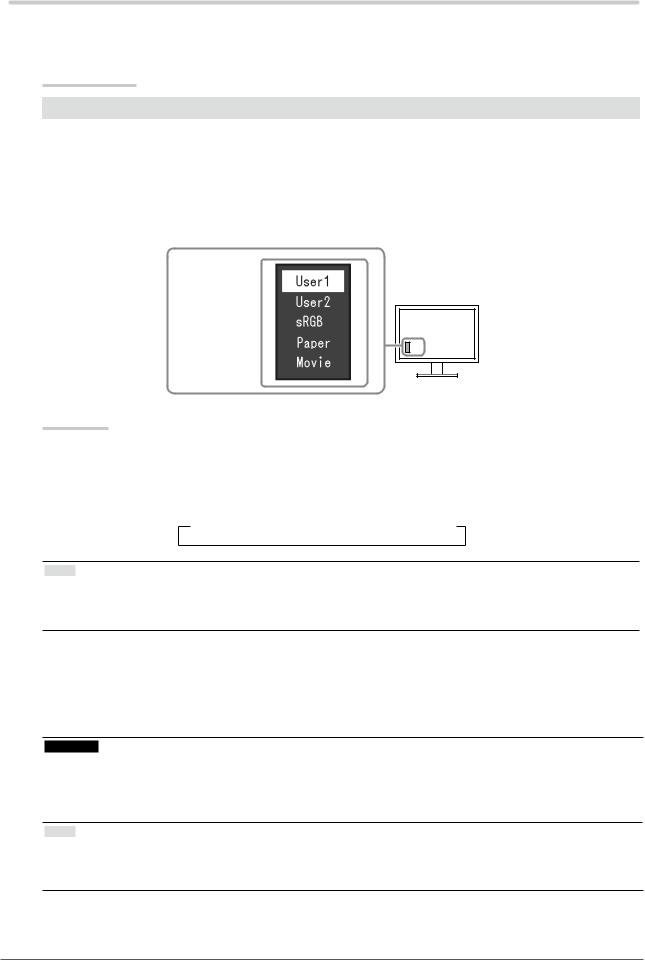
2-3. Adjusting Color
●●To select the display mode (FineContrast Mode)
This function allows easy selection of a desired mode according to monitor application.
Display Modes
Mode |
Purpose |
User1 |
Select this to define a desired set of parameter settings. |
User2 |
|
sRGB |
Suitable for color matching with sRGB compatible peripherals. |
Paper |
Produces a printed paper effect. Suitable for displaying images from media such as books |
|
and documents. |
Movie |
Suitable for playing back animated images. |
The mode menu appears.
Procedure
1.Press
 .
.
The mode menu appears at the bottom left of the screen.
2.The mode among the list is highlighted in turn each time
 is pressed.
is pressed.
You can switch the mode with or
or while the mode menu is displayed.
while the mode menu is displayed.
→User1←→User2←→sRGB←→Paper←→Movie←
Note
•The Setting menu and the Mode menu cannot be displayed at the same time.
•“ScreenManager Pro for LCD (DDC/CI)” allows you to select the FineContrast mode automatically according to the application used (see “Chapter 3 Auto FineContrast” in the “ScreenManager Pro for LCD (DDC/CI)” User’s Manual).
●●To perform advanced adjustments
The “Color” menu of the Setting menu allows you to set and save the independent color adjustment for each mode.
Attention
•It takes about 30 minutes for the performance of electrical parts to stabilize. Please wait 30 minutes or more after the monitor power has been turned on, and then adjust the monitor.
•The same image may be seen in different colors on multiple monitors due to their monitor-specific characteristics. Make fine color adjustment visually when matching colors on multiple monitors.
Note
•Using the “ScreenManager Pro for LCD (DDC/CI)” allows you to perform the color adjustment by using the mouse and keyboard of your PC. (Refer to “Chapter 4 Color Adjustment” in the User’s Manual for “ScreenManager Pro for LCD (DDC/CI)”.)
Chapter 2 Adjusting Screens 15

●●Adjustable settings in each mode
The adjustable settings depend on the mode. (Non-adjustable or non-settable function cannot be selected.) √: Adjustable -: Not adjustable
Function |
|
FineContrast Mode |
|
||||
User1 |
User2 |
sRGB |
Paper |
Movie |
|||
|
|
||||||
Brightness |
|
√ |
√ |
√ |
√ |
√ |
|
Contrast |
|
√ |
√ |
- |
- |
√ |
|
Temperature |
|
√ |
√ |
- |
√ |
√ |
|
Gamma |
|
√ |
√ |
- |
- |
- |
|
Advanced Settings |
Saturation |
- |
- |
- |
- |
√ |
|
|
Hue |
- |
- |
- |
- |
√ |
|
|
Overdrive |
√ |
√ |
- |
- |
- |
|
|
Gain |
√ |
√ |
- |
- |
- |
|
Color Reset |
|
√ |
√ |
√ |
√ |
√ |
|
●●To adjust brightness
The screen brightness is adjusted by changing the brightness of the backlight (light source from the LCD back panel).
Adjustable range
0 to 100
Procedure
1.Press

 .
.
2.Use or
or for adjustment.
for adjustment.
3.Press

 to exit.
to exit.
Note
•If you feel that the image is too dark even if the brightness is set to 100, adjust the contrast.
•Alternatively, you can use “Brightness” under “Color” in the Adjustment menu to adjust it.
•To adjust the screen brightness automatically and comfortably, see “4-3. Enabling / Disabling Automatic Brightness Adjustment” (page 27).
16 Chapter 2 Adjusting Screens
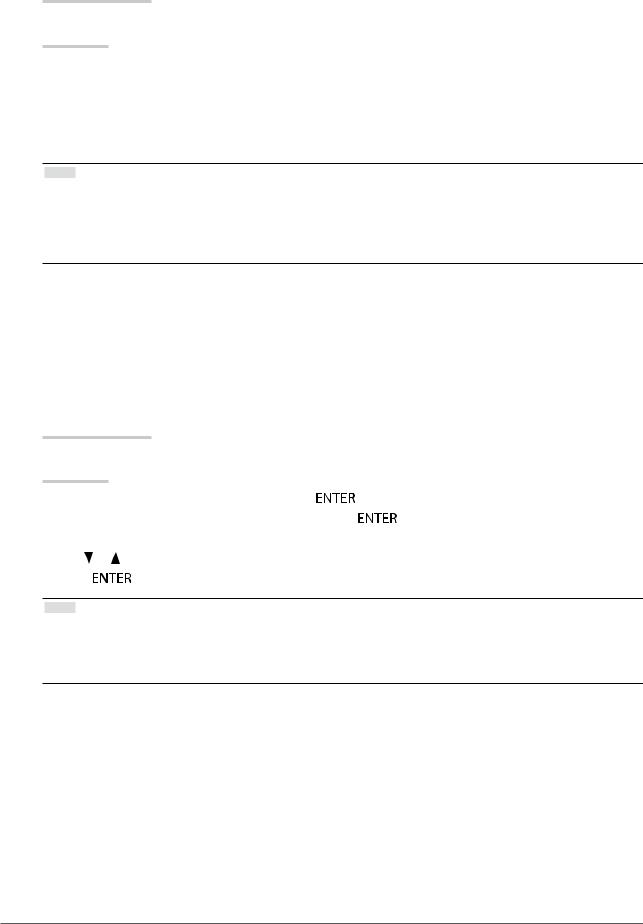
●●To adjust contrast
The brightness of the screen is adjusted by varying the video signal level.
Adjustable range
0 to 100
Procedure
1.Choose “Color” in the Setting menu, and press
 .
.
2.Choose “Contrast” in the “Color” menu, and press
 .
.
The “Contrast” menu appears.
3.Use or
or for adjustment.
for adjustment.
4.Press
 to exit.
to exit.
Note
•In the contrast of 50, every color gradation is displayed.
•When adjusting the monitor, it is recommended to perform the brightness adjustment which may not lose the gradation characteristics, prior to the contrast adjustment.
•Perform the contrast adjustment in the following cases.
- When you feel the image is too dark even if the brightness is set to 100 (Set the contrast to higher than 50.)
●●To adjust color temperature
Color temperature can be adjusted.
The color temperature is normally used to express the hue of “White” and / or “Black” by a numerical value. The value is expressed in degrees “K” (Kelvin).
The screen becomes reddish at a low color temperature, and bluish at a high color temperature, like the flame temperature. A gain preset value is set for each color temperature setting value.
Adjustable range
Off, 4000 K-10000 K (specified by every 500 K unit, including 9300 K)
Procedure
1. |
Choose “Color” in the Setting menu, and press |
. |
|
2. |
Choose “Temperature” in the “Color” menu, and press |
. |
|
|
The “Temperature” menu appears. |
|
|
3. |
Use or |
for adjustment. |
|
4. |
Press |
to exit. |
|
Note
•The value shown in “K” is available only as reference.
•“Gain” allows you to perform more advanced adjustment (see “To adjust gain” (page 20)).
•If you set to “Off”, the image is displayed in the preset color of the monitor (Gain: 100 for each RGB).
•When gain is changed, the color temperature is changed to “Off”.
Chapter 2 Adjusting Screens 17
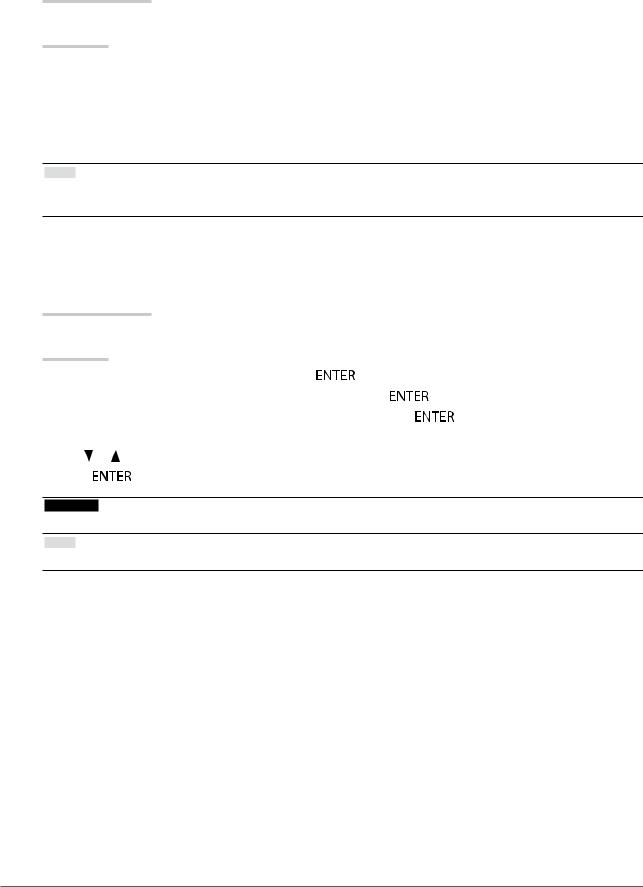
●●To adjust gamma
Gamma can be adjusted. The brightness of the monitor varies depending on the input signal, however, the variation rate is not proportional to the input signal. To keep the balance between the input signal and the brightness of the monitor is called as “Gamma correction”.
Adjustable range
1.8, 2.0, 2.2
Procedure
1.Choose “Color” in the Setting menu, and press
 .
.
2.Choose “Gamma” in the “Color” menu, and press
 .
.
The “Gamma” menu appears.
3.Use or
or for adjustment.
for adjustment.
4.Press
 to exit.
to exit.
Note
•If “Paper” is selected in the FineContrast mode, the gamma value is displayed for “Paper”. The setting “Paper” is specially meant to get the displayed image look like it is printed on paper.
●●To adjust the color saturation
This function allows you to adjust color saturation.
Adjustable range
-50 to 50
Procedure
1. |
Choose “Color” in the Setting menu, and press |
. |
|
|
2. |
Choose “Advanced Settings” in the “Color” menu, and press |
. |
||
3. |
Choose “Saturation” in the “Advanced Settings” menu, and press |
. |
||
|
The “Saturation” menu appears. |
|
|
|
4. |
Use or |
for adjustment. |
|
|
5. |
Press |
to exit. |
|
|
Attention
• Using this function may make some color gradations unavailable for display.
Note
• The minimum value (-50) changes the screen to monochrome.
18 Chapter 2 Adjusting Screens
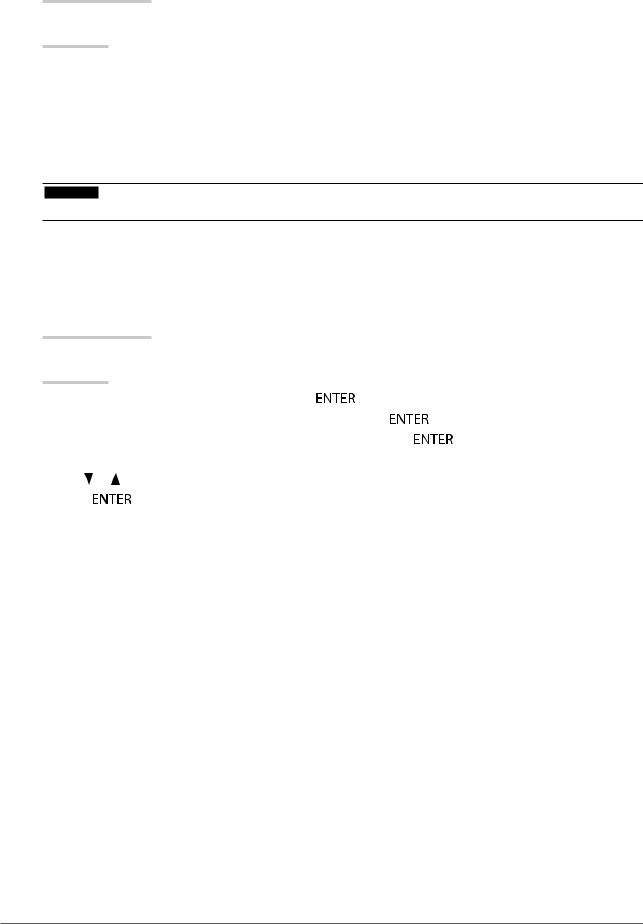
●●To adjust hue
This function allows you to adjust hue.
Adjustable range
-50 to 50
Procedure
1.Choose “Color” in the Setting menu, and press
 .
.
2.Choose “Advanced Settings” in the “Color” menu, and press
 .
.
3.Choose “Hue” in the “Advanced Settings” menu, and press
 .
.
The “Hue” menu appears.
4.Use or
or for adjustment.
for adjustment.
5.Press
 to exit.
to exit.
Attention
• Using this function may make some color gradations unavailable for display.
●●To set overdrive intensity
This function allows you to set overdrive intensity based on the use of the monitor. You can reduce Image lags by setting it to “Enhanced” when displaying animated images.
Adjustable range
Enhanced, Standard, Off
Procedure
1. |
Choose “Color” in the Setting menu, and press |
. |
|
|
2. |
Choose “Advanced Settings” in the “Color” menu, and press |
. |
||
3. |
Choose “Overdrive” in the “Advanced Settings” menu, and press |
. |
||
|
The “Overdrive” menu appears. |
|
|
|
4. |
Use or |
for adjustment. |
|
|
5. |
Press |
to exit. |
|
|
Chapter 2 Adjusting Screens 19
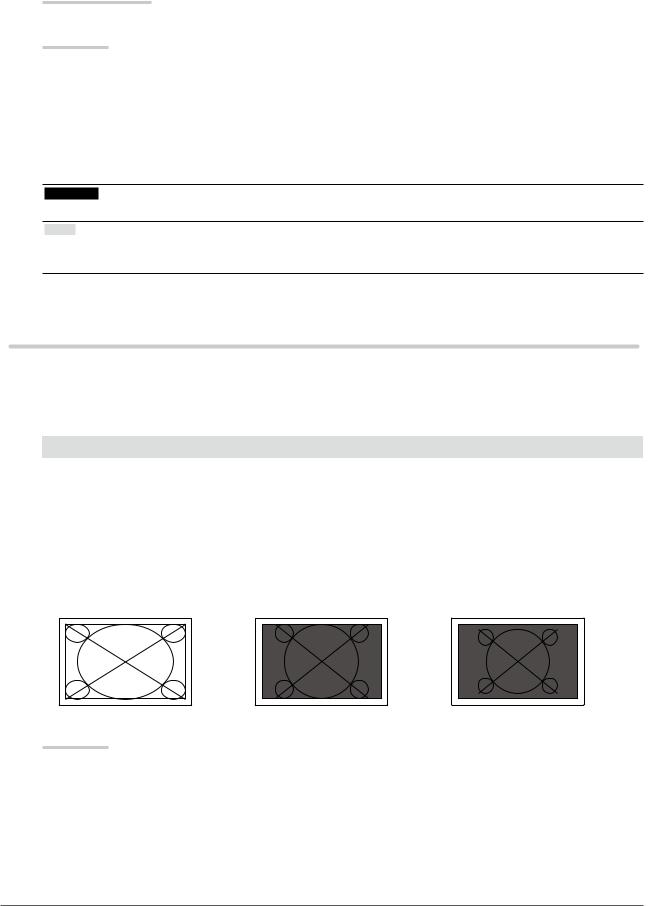
●●To adjust gain
The brightness of each color component red, green, and blue is called “Gain”. You can change the hue of “white” by adjusting gain.
Adjustable range
0 to 100
Procedure
1.Choose “Color” in the Setting menu, and press
 .
.
2.Choose “Advanced Settings” in the “Color” menu, and press
 .
.
3.Choose “Gain” in the “Advanced Settings” menu, and press
 .
.
The “Gain” menu appears.
4.Adjust gain with or
or for each of red, green, and blue.
for each of red, green, and blue.
5.Press
 to exit.
to exit.
Attention
• Using this function may make some color gradations unavailable for display.
Note
•The value of gain changes with that of color temperature.
•When gain is changed, the color temperature is changed to “Off”.
2-4. Screen Size Changing
●●Screen Size Changing
The image with the resolution other than the recommended resolution is displayed in full screen automatically. You can change the screen size by using the “Screen Size” function.
|
Setting |
|
|
|
|
Function |
|
|
|
|
Full Screen |
Displays an image in full screen. Images are distorted in some cases because the vertical |
|||||||||
|
|
|
rate is not equal to the horizontal rate. |
|
|
|
||||
Enlarged |
Displays an image in full screen. In some cases, a blank horizontal or vertical border |
|||||||||
|
|
|
appears to equalize the vertical rate and the horizontal rate. |
|
|
|
||||
Normal |
Displays images with the specified resolution. |
|
|
|
||||||
Example: Image size 1280 × 1024 |
|
|
|
|
|
|
||||
|
Full Screen |
Enlarged |
Normal |
|||||||
|
|
|
|
|
|
|
|
|
|
|
|
|
|
|
|
|
|
|
|
|
|
|
|
|
|
|
|
|
|
|
|
|
|
|
|
|
|
|
|
|
|
|
|
|
|
|
|
|
|
|
|
|
|
|
(2560 × 1440) |
(1800 × 1440) |
(1280 × 1024) |
Procedure
1.Choose “Screen” in the Setting menu, and press

 .
.
2.Choose “Screen Size” in the “Screen” menu, and press

 .
.
The “Screen Size” menu appears.
3.Select “Full Screen”, “Enlarged”, or “Normal” with or
or .
.
4.Press

 to exit.
to exit.
20 Chapter 2 Adjusting Screens
